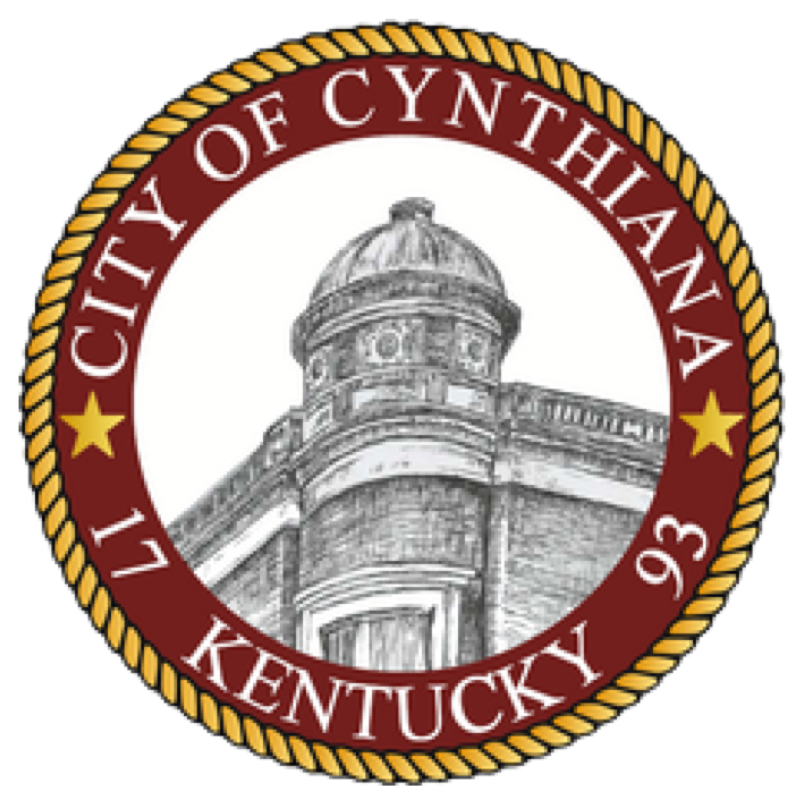A BRIEF HISTORY OF CYNTHIANA, KENTUCKY
by George D. Slade
April 1998
Cynthiana Kentucky is located on the banks of the South Licking River, 28 miles north of Lexington. The town was established in 1793 on the lands of Robert Harrison. According to tradition, the town was named in honor of Harrison’s daughters, Cynthia and Anna. Cynthiana is the seat of Harrison County. The court house, the third, was completed in 1853. The municipal building, the third, was occupied in 1930.
For its first 67 years, the town was governed by a board of trustees. In 1860, it was changed to a council form of government with Samuel January, the first mayor. As of 1998, this form of government still exists with four council persons and a mayor.
During the first 60 years, access to the outside world was gained by traveling about 12 miles overland on foot or by horse drawn equipment to Claysville, on the banks of the Main Licking River, then by barge or boat to the Ohio River. In 1854, the Covington and Lexington Railroad was completed to the town. This allowed round trip travel to Covington and Cincinnati in one day’s time. CSX Railroad now routes several trains daily over the same roadbed, but none stop to pick up or discharge freight or passengers.
During the American Civil War, Cynthiana suffered several property losses at the hands of General John Hunt Morgan’s Confederate forces. Two battles were fought here, July, 1862 and June, 1864. In an attempt to dislodge Union forces, Morgan’s troops set fire to a stable which resulted in most of the downtown area being destroyed.
The town prospered in the early 1900’s. Bourbon whiskey and burley tobacco were the chief exports. At one time, there were more than 30 distilleries in the county producing bourbon whiskey. Among world famous brands made here were Old A. Keller, Old VanHook, and Old Poindexter.
Following World War II, south of Cynthiana, retail stores gradually appeared forcing downtown stores to close. The post office also was moved to that locale.
In a futile attempt to save downtown establishments, several historic structures were leveled to make room for parking lots. A few historic sites remain. The Graveyard (Old Cemetery), in existence before the town was founded, holds the remains of the city’s first mayor and a number of other notable citizens. Battle Grove Cemetery was named for the Civil War battle fought on that site in June, 1864. The Church of the Advent, built in 1855, is patterned after the church in Stoke Poges, England where Thomas Gray wrote, “Elegy written in a Country Church Yard.” This church building was used as a hospital following the Civil War battles.
Other historic landmarks are the old log cabin behind the court house; two story brick building across from the court house with a stone near the eaves bearing the date of construction, 1812; Crown Jewel Milling building; old jail built 1886 from locally quarried limestone; Rankin Hotel; sites connected to David Sheely and his ghost; Death Valley Scotty’s birthplace; watering trough for horses; many iron front buildings; and the Cynthiana-Harrison Museum which is filled with hundreds of items related to local history (a must for visitors to Cynthiana).
Places of interest near Cynthiana are the Endicott Meeting House (Indian Creek Baptist Church) where church services have been held regularly since 1790, Stony Castle built 1807, Cherry Grove Cemetery which was established in 1869 by black citizens, and the site of Ruddle’s Fort.
Cynthiana and Harrison County boast an excellent educational system with four elementary schools, one middle school, one high school, and a vocational school as well as a branch of Maysville Community College. There is a modern public library on Main Street with its Kentucky Room devoted to local and state records. Court House records are complete and available for obtaining information. Harrison Memorial Hospital, Millersburg Pike, is an outstanding modern facility.
The following are individuals who have in some way been a part of Cynthiana’s history (not necessarily listed in order of name recognition): native Death Valley Scotty, Robert Harrison, Henry Clay, Joseph Desha (governor 1824-1828), native Federal Judge Mac Swinford, resident Dr. George H. C. Todd (brother of Mary Todd Lincoln), native Joe B. Hall, William Jennings Bryan, resident Reverend Samuel Rogers (evangelist), General John Hunt Morgan, resident Heber Hicks, Curtis Jett, Joseph Fennell, Lord Halifax, resident Moy Foo, McKnight family (their boarding house/restaurant), native Lawrence Pressman (actor), marksman Ed Topperwein, Biancke family (restaurant), native author Lucinda Boyd, native Jack Cason (president of the Texas Book Depository), native Edwin Cleary (actor, railway builder, war correspondent), renowned piscator Dr. James A Henshall, native Gary Sandy (actor), composer and band leader John P. Sousa, and native Bill McKinney (big band, McKinney’s Cotton Pickers).









